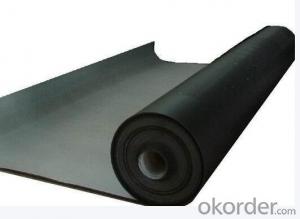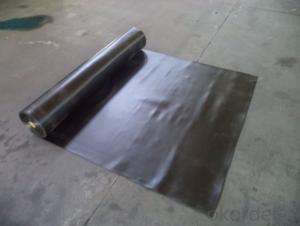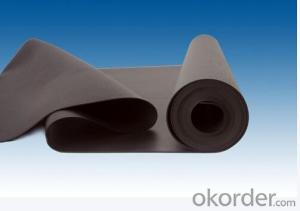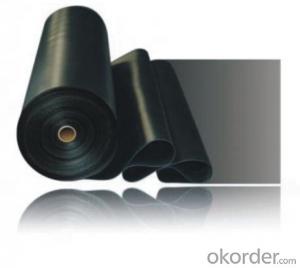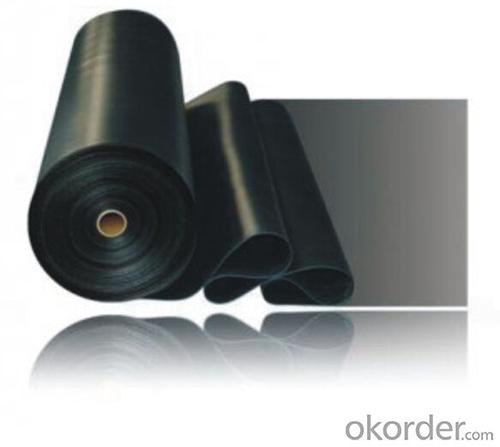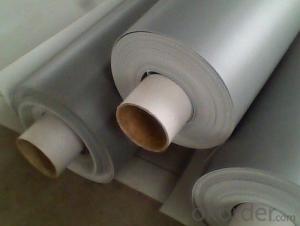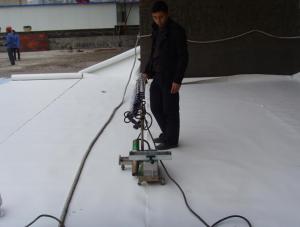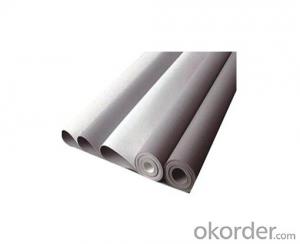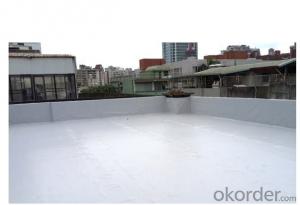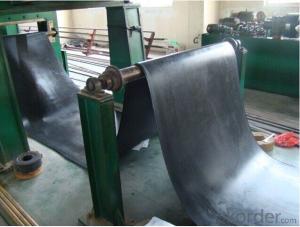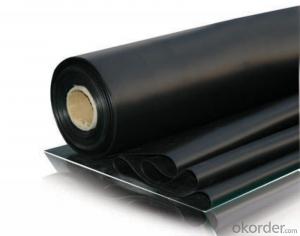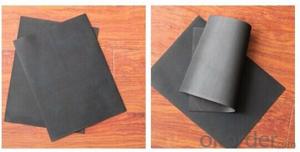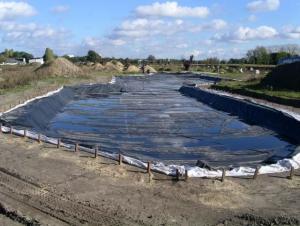Black EPDM Pond Liners For Fish Pond Use
- Loading Port:
- Qingdao
- Payment Terms:
- TT OR LC
- Min Order Qty:
- 2000 m²
- Supply Capability:
- 100000 m²/month
OKorder Service Pledge
OKorder Financial Service
You Might Also Like
EPDM waterproofing roofing membrane
1. Introduction:
EPDM Pond Liners is the modified materials.They are based upon EPDM rubber with modifier,
softener and accelerant assistants added to provide flexibility and stability. Through the precise ingredients, mixing, extrusion, rolling, curing processes, this is made of modified EPDM Waterproofing material with high strength and high flexibility.
2. Specification:
Name | Thickness(mm) | Width(m) | Length(m) |
EPDM | 1.2-2.0 | 2.0-4.0 | 20 |
3. Technical Data:
The item name | Indication | Applicable test items | ||||
Tension Strength (MPa) | Normal temperature≥ | 7.5 | GB6.3.2 | |||
60°C≥ | 2.3 | |||||
Elongation at break | Normal temperature≥ | 450 | ||||
-20°C | 200 | |||||
Tear strength N ≥ | 25 | GB6.3.3 | ||||
(0.3Mpa.30 min)Water tightness | No seeage | GB6.3.4 | ||||
Flexibility at low temperature ≤ | -40 | GB6.3.5 | ||||
Heat expansion (mm) | Extended ≤ | 2 | GB6.3.6 | |||
Contraction ≤ | 4 | |||||
(80°C×168h) | Fracture tensile strength retention %≥ | 80 | GB6.3.7 | |||
Hot air ageing | Keep rate tore elongation | 70 | ||||
%≥ | ||||||
Alkaline [10%Ca(OH)2Normal temperature×168h] | Fracture tensile strength retention %≥ | 80 | GB6.3.8 | |||
Keep rate tore elongation%≥ | 80 | |||||
Ozone aging | — | GB6.3.9 | ||||
Artificial climate ageing | Fracture tensile strength retention %≥ | 80 | GB6.3.10 | |||
Elongation at break %≥ | 70 | |||||
Bond peel strength | Standard test condition | 1.5 | GB6.3. | |||
4. Product Show:
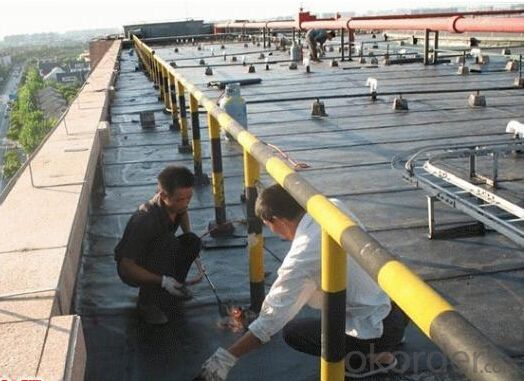
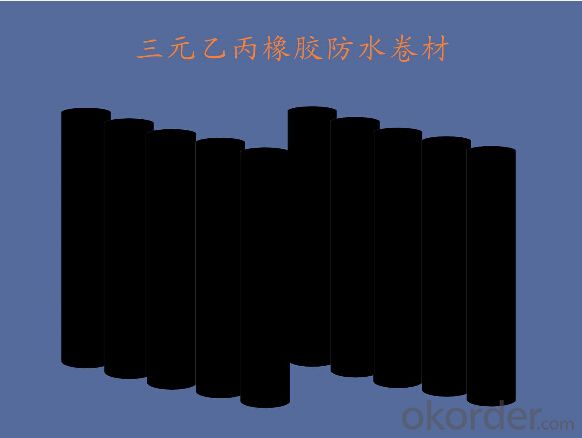
- Q: Coil waterproof roofing requirements
- 1, grass-roots level, leveling layer strength in line with regulatory requirements, can not afford to sand, no cracking, the surface clean no waste residue;
- Q: Can a waterproofing membrane be recycled or disposed of in an environmentally friendly manner?
- Yes, a waterproofing membrane can be recycled or disposed of in an environmentally friendly manner. Many waterproofing membranes are made from recyclable materials such as polyethylene or polypropylene, which can be recycled into new products. Recycling these membranes not only reduces waste but also conserves resources and reduces the environmental impact of manufacturing new materials. To recycle a waterproofing membrane, it is important to check with local recycling facilities or waste management centers to see if they accept this type of material. Some facilities may have specific guidelines or processes for recycling membranes, so it is crucial to follow their instructions. In cases where recycling is not feasible, disposing of the waterproofing membrane in an environmentally friendly manner is still possible. Many waste management facilities have designated areas for construction and demolition waste, where the membrane can be properly disposed of. These facilities employ techniques to minimize the impact of the waste on the environment, such as containment and controlled disposal methods. It is essential to avoid disposing of the membrane in regular trash or dumping it illegally, as this can harm the environment and contribute to pollution. Proper disposal ensures that any potential pollutants or contaminants in the membrane are managed appropriately, preventing harm to ecosystems and human health. Overall, by recycling or disposing of a waterproofing membrane in an environmentally friendly manner, we can contribute to a more sustainable and cleaner future.
- Q: Can a waterproofing membrane be used for storage tanks or containment areas?
- Storage tanks or containment areas can utilize a waterproofing membrane to prevent water or liquid penetration. These membranes serve as a barrier against such infiltrations and are therefore ideal for containment purposes. Rubber, PVC, or bitumen are commonly used materials for these membranes due to their water-resistant properties. They can be applied either internally or externally to storage tanks or containment areas to safeguard against leaks and moisture-related deterioration. Moreover, the use of waterproofing membranes aids in preventing the development of mold or mildew, thereby ensuring a secure and hygienic environment for stored materials or liquids.
- Q: Can a waterproofing membrane be used on precast copper surfaces?
- Precast copper surfaces can indeed utilize a waterproofing membrane. These membranes possess adaptability and can be utilized across a diverse range of surfaces, including copper. Their primary purpose is to establish a protective barrier that hinders water infiltration and safeguards the underlying structure from moisture-induced harm. With accurate application, a waterproofing membrane can proficiently seal precast copper surfaces, securing enduring defense against water intrusion. Nevertheless, it is vital to verify the compatibility of the membrane with copper and conduct thorough surface preparation to guarantee optimal adhesion and performance.
- Q: What is the difference between construction non-vulcanized waterproofing membrane and vulcanized waterproofing membrane?
- Non-vulcanized rubber waterproofing membrane: from SR or SR and asphalt blends by mixing, rolling made of coil, without vulcanization can use the product. The bonding between the coils and their bonding properties with the mortar is good, the manufacturing is convenient, the price is low, but the tensile strength is low. Can be divided into two types of rubber and rubber asphalt. Rubber type commonly used SBR and other SR production. Generally used for civil construction roof waterproof.
- Q: Can a waterproofing membrane be used in geotechnical applications?
- Indeed, geotechnical applications can make effective use of waterproofing membranes. These membranes are commonly employed to safeguard structures against water infiltration and are applied to various surfaces such as roofs, basements, and foundations. In geotechnical applications, these membranes serve the purpose of preventing water from seeping into the soil, thus averting erosion and stabilizing slopes. They can be positioned either horizontally or vertically to establish a barrier that hinders water penetration, which proves particularly advantageous in retaining walls, embankments, and dams. Furthermore, waterproofing membranes can be used to regulate water flow and enhance drainage in geotechnical projects. All in all, incorporating a waterproofing membrane into geotechnical applications can significantly enhance the longevity and performance of structures while effectively safeguarding them against water-related issues.
- Q: Are waterproofing membranes suitable for historical preservation projects?
- Waterproofing membranes can be suitable for historical preservation projects, depending on the specific circumstances and goals of the project. Waterproofing membranes are designed to provide a protective barrier against water infiltration, which can help to prevent damage to historical structures caused by moisture. In some cases, historical buildings may have existing waterproofing systems that are deteriorated or no longer effective. In these situations, the use of modern waterproofing membranes can be a viable option to protect and preserve the structure. These membranes can be installed discreetly, without altering the original appearance or architectural integrity of the building. However, it is crucial to approach the use of waterproofing membranes in historical preservation projects with caution. The potential impact on the authenticity and historical value of the structure must be carefully evaluated. Some historical buildings may have unique construction methods or materials that require specialized preservation techniques. In such cases, alternative preservation methods that do not involve the use of membranes may be more appropriate. Additionally, it is important to consider the long-term consequences and maintenance requirements of waterproofing membranes. Some membranes may have a limited lifespan, and periodic inspections and maintenance may be necessary to ensure their continued effectiveness. This ongoing maintenance should be factored into the overall preservation plan and budget. Ultimately, the decision to use waterproofing membranes in historical preservation projects should be based on a thorough assessment of the specific needs and characteristics of the building, as well as the preservation objectives. Consulting with preservation experts, architects, and engineers can help to determine the most suitable approach for each unique project.
- Q: Does a waterproofing membrane require any specific preparation of the substrate before installation?
- Yes, a waterproofing membrane typically requires specific preparation of the substrate before installation. The substrate needs to be clean, dry, and free from any debris, oils, or contaminants that may hinder adhesion. It may also require smoothing or leveling of the surface to ensure proper application and effectiveness of the membrane.
- Q: How long does it take for a waterproofing membrane to cure?
- The time it takes for a waterproofing membrane to cure can vary depending on various factors such as the type of membrane, environmental conditions, and the specific product being used. Generally, most waterproofing membranes require at least 24 to 48 hours to fully cure. During this time, the membrane undergoes a chemical reaction that allows it to form a durable, impermeable barrier. However, it is important to note that curing times can be influenced by factors like temperature, humidity, and the thickness of the applied membrane. It is always recommended to follow the manufacturer's instructions and allow ample time for the membrane to cure before subjecting it to any stress or water exposure.
- Q: Can a waterproofing membrane be used for tunnels or underground structures?
- Yes, a waterproofing membrane can be used for tunnels or underground structures. Waterproofing membranes are specifically designed to prevent the ingress of water and protect structures from moisture damage. Tunnels and underground structures are often exposed to groundwater or high levels of moisture, making waterproofing essential to maintain their integrity and durability. The waterproofing membrane is applied to the exterior surface of the tunnel or underground structure, creating a barrier that prevents water penetration. It acts as a protective layer, preventing water from seeping through the walls, roof, or floor. There are various types of waterproofing membranes available, including bituminous, polyurethane, and cementitious membranes. Each type offers different properties and advantages depending on the specific requirements of the project. In addition to preventing water infiltration, waterproofing membranes also provide protection against other potential issues such as corrosion, mold growth, and structural damage. They help to extend the lifespan of the tunnel or underground structure and reduce maintenance and repair costs. It is important to ensure that the waterproofing membrane is properly installed by qualified professionals to ensure its effectiveness. Regular inspections and maintenance are also crucial to identify any potential issues and address them promptly. Overall, a waterproofing membrane is a highly effective solution for tunnels and underground structures, providing long-lasting protection against water damage and ensuring their structural integrity.
Send your message to us
Black EPDM Pond Liners For Fish Pond Use
- Loading Port:
- Qingdao
- Payment Terms:
- TT OR LC
- Min Order Qty:
- 2000 m²
- Supply Capability:
- 100000 m²/month
OKorder Service Pledge
OKorder Financial Service
Similar products
Hot products
Hot Searches
Related keywords
